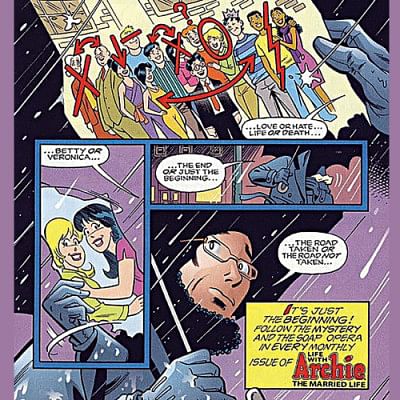Growing up with ‘Archie’ comics

As a tiny five-year old in the '80s, I first discovered and liberated an Archie comic from a teenage cousin the way oil rich countries are liberated: by force. I used superior tactics of crying, pleading, whining and bargaining. All because I saw a lot of cars in the panels. And aliens and kids doing cool stuff that I had never seen before. I had never seen a comic before. I couldn't even read.
All through the '90s I spent all my lunch money buying these comic books. Recently, from my old stash, I found that I still have that book. Memories came flooding back.
Why Archie?
Started in 1941, Archie revolves around the inhabitants of a fanciful American city where the red haired high-schooler experiences friendship, music, and love triangles. The early comics ignored political connotations of race and bigotry. Even school bullies weren't terrifying: Someone would get stuffed into a school locker. Maybe get roughed up during sports. But it would all end on a note of friendship, self-realisation, or the bullies getting egg on their faces. It was all quite utopian and sterilised but then, that's what an often confused adolescent needs—the constant underlying theme of friendship.
I and my friends, who read and borrowed and never returned many of my comics, all read Archie till late in school life. Archie's problems were the same issues bugging us.
College is where it petered out for most. When you're hitting close to 20, Archie's colourful life seems that much farther off in the distance. It becomes a popular bathroom read for many.
Is that the end though?
Seems not. Archie has always evolved with the times. In 1989 a 12 issue tie-in series with toy manufacturer Kyosho featured Archie and the gang racing across all states using various remote control vehicles. Other titles like Archie 3000 showed life in, well, year 3000. Hovercrafts, lasers, and alien invasions all with the same underlying message that friendship comes above all else.
The biggest evolution came in the last decade when people slowly started giving in to the mind control allure of the smartphone. Were people still reading Archie? Not the kids I knew. Popular bookshops like Boi Bichitra, PBS, and Bookworm still keep a stack, but sales have dropped. Readership declined worldwide for Archie all through the 2000s until John Goldwater stepped in as CEO in 2009, bringing in new creators and new concepts.
In 2013, Afterlife with Archie came in featuring a bit of undead thrill. It exposed the popular Riverdale characters to a zombie invasion. For readers and older fans, this wasn't the sterilised content we'd been privy to—without divulging spoilers, characters died, or rather, became undead. And died.
It was a gritty 12 part reboot unlike anything in the series before. A fantastic tale with unexpected twists that were actually scary. Extremely successful, it showed that a larger market was ready for darker Archie material.
Earlier in 2010, the revived Life with Archie series featured two alternate universes, each showing Archie dealing with grownup issues of marital strife, cancer, financial problems, and dreams that don't work out. It dealt with then risky topics of gun control and same sex marriage, but still followed the underlying themes of love and friendship. In 2014, though, Archie died, shot while saving his friend Kevin, the first gay character in the comic series.
Death isn't part of the Archie mythos. Readers are used to comic book deaths being temporary, like fast internet in Bangladesh. But this wasn't. The series ended there with a strong message, while other titles continued the Archie life, modernised and now carrying the all-pervasive cell phone.
Recently, my school-going son picked up an issue of Archie that he dug out of my book stash. I'm curious to see what he thinks of it while both he and Archie keep growing up.
Ehsanur Raza Ronny is editor of Toggle, The Daily Star.

 For all latest news, follow The Daily Star's Google News channel.
For all latest news, follow The Daily Star's Google News channel. 



Comments